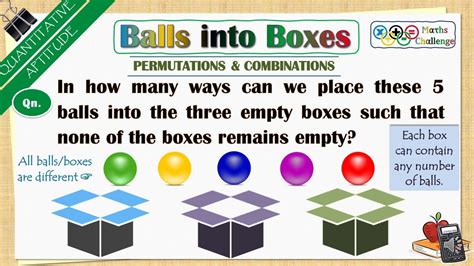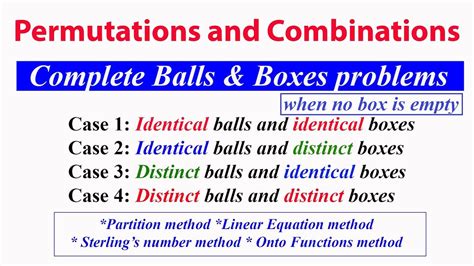distributing particles into three boxes How many different ways I can keep $N$ balls into $K$ boxes, where each box should at least contain $1$ ball, $N >>K$, and the total number of balls in the boxes should be $N$? For . Multipurpose electrical junction enclosure with integrated adjustable cable clamps. Designed for use with Wago 224 series connectors (sold separately). Supports upto 6 cables.
0 · how to divide balls into boxes
1 · how to distribute n boxes
2 · how to distribute k into boxes
3 · how to distribute k balls into boxes
4 · dividing balls into boxes pdf
5 · distribution of balls into boxes pdf
6 · distributing balls to boxes
Our JB08 Low Voltage Junction Box is an easy and efficient way to connect all your lighting lines to one place. Junction box's help prevent drop voltage in your landscape lights and bring ease to mind knowing all of your connections are in one place for future troubleshooting.
In this section, we want to consider the problem of how to count the number of ways of distributing k balls into n boxes, under various conditions. The conditions that are generally imposed are the following: 1) The balls can be either distinguishable or indistinguishable. 2) The boxes can be . If $r$ particles have been allocated, producing particle counts $(r_k)_{k=1,..,N}$ in the $N$ boxes (so $\sum_{k=1}^Nr_k=r$), then allocate the next particle to box-number $X$, .
How many different ways I can keep $N$ balls into $K$ boxes, where each box should at least contain $ ball, $N >>K$, and the total number of balls in the boxes should be $N$? For .Let's have a look at an example with $N=2$ indistinguishable balls and $m=2$ distinguishable boxes. So, after distributing the $ balls into the $ boxes, we can see one of three possible .
The formula for distributing 5 objects to 3 boxes is known as the combination formula, represented as C(n,r) = n! / (r!(n-r)!). In this case, n = 5 and r = 3, so the formula . We complete section 6.5 by looking at the four different ways to distribute objects depending on whether the objects or boxes are indistinguishable or distinct. We finish up with . How many different ways can you distribute three indistinguishable particles in a 3 x 3 ensemble of distinguishable boxes? Hint: Allow up to 3 particles per box and require at least 1 particle per occupied box to organize .Know the basic concept of permutation and combination and learn the different ways to distribute the balls into boxes. This can be a confusing topic but with the help of solved examples, you .
The property that characterizes a distribution (occupancy) problem is that a ball (object) must go into exactly one box (bin or cell). This amounts to a function from balls to bins.
The answer is that each distribution of balls in boxes in the original question can be identified with a partition of the balls when they are arranged in a line. For example, if I have 3 boxes and 7 .
In this section, we want to consider the problem of how to count the number of ways of distributing k balls into n boxes, under various conditions. The conditions that are generally imposed are the following: 1) The balls can be either distinguishable or indistinguishable. 2) The boxes can be either distinguishable or indistinguishable. If $r$ particles have been allocated, producing particle counts $(r_k)_{k=1,..,N}$ in the $N$ boxes (so $\sum_{k=1}^Nr_k=r$), then allocate the next particle to box-number $X$, where $X$ is chosen from $\{1,.,N\}$ according to the probability distribution specified by $$P(X=k)={r_k+1\over r+N}\,[k\in\{1,.,N\}].$$How many different ways I can keep $N$ balls into $K$ boxes, where each box should at least contain $ ball, $N >>K$, and the total number of balls in the boxes should be $N$? For example: for the case of $ balls and $ boxes, there are three different combinations: $(1,3), (3,1)$ , and $(2,2)$ .Let's have a look at an example with $N=2$ indistinguishable balls and $m=2$ distinguishable boxes. So, after distributing the $ balls into the $ boxes, we can see one of three possible outcomes: \begin{array}{rcl} \text{Box $} &|& \text{Box $} \ \hline \bullet\;\bullet &|& \ \bullet &|& \bullet \ &|&\bullet\; \bullet \end{array}
The formula for distributing 5 objects to 3 boxes is known as the combination formula, represented as C(n,r) = n! / (r!(n-r)!). In this case, n = 5 and r = 3, so the formula becomes C(5,3) = 5! / (3!(5-3)!) = 5! / (3!2!) = (5x4x3) / (2x1) = 10. We complete section 6.5 by looking at the four different ways to distribute objects depending on whether the objects or boxes are indistinguishable or distinct. We finish up with a practice. How many different ways can you distribute three indistinguishable particles in a 3 x 3 ensemble of distinguishable boxes? Hint: Allow up to 3 particles per box and require at least 1 particle per occupied box to organize yourself. Here are some subscenarios: 3) No two boxes in the same row contain the same number of particles.Know the basic concept of permutation and combination and learn the different ways to distribute the balls into boxes. This can be a confusing topic but with the help of solved examples, you can understand the concept in a better way.
The property that characterizes a distribution (occupancy) problem is that a ball (object) must go into exactly one box (bin or cell). This amounts to a function from balls to bins.The answer is that each distribution of balls in boxes in the original question can be identified with a partition of the balls when they are arranged in a line. For example, if I have 3 boxes and 7 identical balls, I could place the 7 balls in a line like so: $$*****$$ Then to represent how these balls are placed in the boxes, I simply .In this section, we want to consider the problem of how to count the number of ways of distributing k balls into n boxes, under various conditions. The conditions that are generally imposed are the following: 1) The balls can be either distinguishable or indistinguishable. 2) The boxes can be either distinguishable or indistinguishable.

If $r$ particles have been allocated, producing particle counts $(r_k)_{k=1,..,N}$ in the $N$ boxes (so $\sum_{k=1}^Nr_k=r$), then allocate the next particle to box-number $X$, where $X$ is chosen from $\{1,.,N\}$ according to the probability distribution specified by $$P(X=k)={r_k+1\over r+N}\,[k\in\{1,.,N\}].$$How many different ways I can keep $N$ balls into $K$ boxes, where each box should at least contain $ ball, $N >>K$, and the total number of balls in the boxes should be $N$? For example: for the case of $ balls and $ boxes, there are three different combinations: $(1,3), (3,1)$ , and $(2,2)$ .Let's have a look at an example with $N=2$ indistinguishable balls and $m=2$ distinguishable boxes. So, after distributing the $ balls into the $ boxes, we can see one of three possible outcomes: \begin{array}{rcl} \text{Box $} &|& \text{Box $} \ \hline \bullet\;\bullet &|& \ \bullet &|& \bullet \ &|&\bullet\; \bullet \end{array}
The formula for distributing 5 objects to 3 boxes is known as the combination formula, represented as C(n,r) = n! / (r!(n-r)!). In this case, n = 5 and r = 3, so the formula becomes C(5,3) = 5! / (3!(5-3)!) = 5! / (3!2!) = (5x4x3) / (2x1) = 10. We complete section 6.5 by looking at the four different ways to distribute objects depending on whether the objects or boxes are indistinguishable or distinct. We finish up with a practice.
how to divide balls into boxes
how to distribute n boxes
How many different ways can you distribute three indistinguishable particles in a 3 x 3 ensemble of distinguishable boxes? Hint: Allow up to 3 particles per box and require at least 1 particle per occupied box to organize yourself. Here are some subscenarios: 3) No two boxes in the same row contain the same number of particles.
Know the basic concept of permutation and combination and learn the different ways to distribute the balls into boxes. This can be a confusing topic but with the help of solved examples, you can understand the concept in a better way.The property that characterizes a distribution (occupancy) problem is that a ball (object) must go into exactly one box (bin or cell). This amounts to a function from balls to bins.

how to distribute k into boxes
how to distribute k balls into boxes
dividing balls into boxes pdf

Discover Company Info on VULCAN FABRICATED METALS, INC. in Montgomery, AL, such as Contacts, Addresses, Reviews, and Registered Agent.With more than 20 CNC machines, Vulcan Machining will find the best solution for your machined product or assembly needs. Our eight machining centers have a size range up to 50” x 26” x 25” and four lathes range to 39” OD x 39” long. .
distributing particles into three boxes|how to distribute k balls into boxes